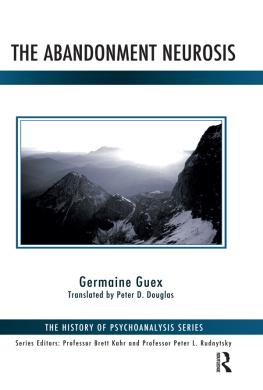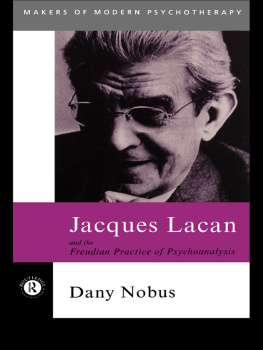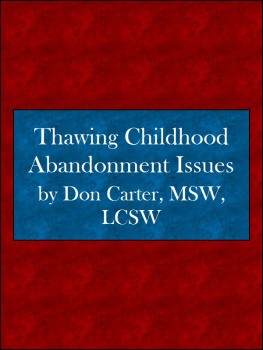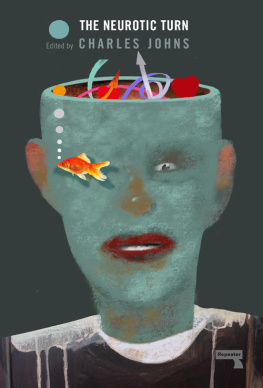First published 2015 by Karnac Books Ltd.
Copyright 2015 to Peter D. Douglas for this English edition.
The right of Germaine Guex to be identified as the author of this work has been asserted in accordance with 77 and 78 of the Copyright Design and Patents Act 1988.
All rights reserved. No part of this book may be reprinted or reproduced or utilised in any form or by any electronic, mechanical, or other means, now known or hereafter invented, including photocopying and recording, or in any information storage or retrieval system, without permission in writing from the publishers.
Product or corporate names may be trademarks or registered trademarks, and are used only for identification and explanation without intent to infringe.
A C.I.P. for this book is available from the British Library
Translation by Peter D. Douglas
Germaine Guex was born on 17 April 1904 in Arcachon, Aquitaine, France, and died on 20 November 1984 in Lausanne, Switzerland.
Her father, Georges Guex, was a native of Switzerland and a Protestant pastor. Her mother Hlne, ne Millet, was French, and died when her daughter was still young. At seventeen, Germaine Guex moved to Switzerland and lived with her aunt. There, she studied education and psychology at the Institut Jean-Jacques Rousseau in Geneva until 1923, after which she worked as an assistant to Jean Piaget in the psychology laboratory of the Institute until 1930. During this time, she became familiar with the work of Freud, completed a training analysis with Raymond de Saussure, and became a member and training analyst at the Socit Suisse de Psychoanalyse.
Above all, Guex was drawn to clinical work, so, in 1930, she was recruited by psychoanalyst Dr Andr Rpond, director of psychiatry in the Malvoz clinic, Valais, Switzerland, to oversee a psychoanalytically inspired medical unit and psychological counselling centre for children and parents. Being both a therapeutic and preventative facility, it was the first of its kind, and became the model for similar institutions in Switzerland and France. Three years later, Guex contracted tuberculosis and had to forego this work. She moved to Lausanne, where she met her partner to be, the Swiss psychoanalyst Charles Odier (18861954).
After the Second World War, Guex began teaching at the Raymond de Saussure SwissFrench psychoanalytic education centre in Geneva. With Odier and Henry Flournoy, she sought to combine Freudian psychoanalysis with the genetic and psychological theories of Piaget. The research was, for the most part, inspired and shaped by their concept of what became known as abandonment neurosis, which they argued had a pre-oedipal aetiology, founded on the individuals fear of abandonment and need for affective security.
This research culminated with Guexs book, La nvrose dabandon , first published in 1950, which was, and still is, a ground-breaking work. Her research turns on two observations: the frequent occurrence of analysands whose neurotic symptoms are unrecognisable when measured against any of the Freudian diagnostic models, and the relatively large number of these patients who sought help from her, having already undergone thorough, classically Freudian treatments with analysts whose abilities and credentials were never in question, but who, none the less, could do nothing to relieve the suffering of these patients. What the analysands all had in common, Guex observed, were extreme, life-debilitating feelings of abandonment, insecurity, and lack of self-worth, originally ignited by severe pre-oedipal trauma.
Guex describes abandonment neurosis in terms of how to identify it diagnostically. She then goes on to outline every tool and treatment methodology, developed over many years of clinical practice, which can be deployed in the successful and lasting eradication of this pervasive pathology, repairing shattered lives in ways that seems to achieve the impossible, by helping these neurotics adapt to the rigours of reality and, ultimately, establish meaningful, ongoing relations with others.
Contents
CHAPTER ONE
Clinical description of symptomatology
CHAPTER TWO
Structures
CHAPTER THREE
Aetiology
CHAPTER FOUR
Therapy
Guide
There are a number of people I would like to thank, and without whose help it would not have been possible to even start this project, let alone complete it. They are: Sue Graebner, the linguistic wizard who pored over every word of this manuscript and made many invaluable improvements, both to the works technical sense and to its clarity; my great friend Terry Aspinall, who first gave me the belief to get up under the lights; Wilson Main, who never gave up on me; Margaret Hansford, who saved my life; the Gilberts, Viv, Dave, Geraldine, and David, my adopted family, who gave me that priceless sense of belonging; the 1972 38th intake of Marks and Morrow Divi sions at HMAS Leeuwin together we learnt to overcome and just what might be possible if you want it enough; and finally, I would like to offer my everlasting thanks to Dr Robin L. Chester.
Balint, M. (1969). The Basic Fault: Therapeutic Aspects of Regression . New York: Brunner/Mazel, 1979.
Behn-Eschenburg, H. (1935). The antecedents of the Oedipus complex. International Journal of Psychoanalysis, XVI (2): 184.
Burlingham, D., & Freud, A. (1942). Young Children In Wartime. London: George Allen & Unwin.
Burlingham, D., & Freud, A. (1947). Infants Without Families. London: George Allen & Unwin.
Fanon, F. (1952). Black Skin, White Masks , R. Philcox (Trans.). New York: Grove Press, 2008.
Fenichel, O. (1945). The Psychoanalytic Theory of Neurosis. New York: W. W. Norton.
Freud, S. (1914c). On narcissism: an introduction. S.E ., : 73101. London: Hogarth.
Harris, A. (2015). Language is there to bewilder itself and others: the clinical and theoretical contributions of Sabina Spielrein. Plenary address to the National Meeting of the American Psychoanalytic Association, New York.
Lampl-De Groot, J. (1975)[1946]. The pre-oedipal phase. Psychoanalytic Study of the Child, 2 : 7583.
Laplanche, J., & Pontalis, J.-B. (1967). The Language of Psycho-Analysis , D. Nicholson-Smith (Trans.). New York: Norton, 1973.
Odier, C. (1956). Anxiety and Magic Thinking , M. Schoelly & M. Sherfey (Trans.). New York: International Universities Press.
Rudnytsky, P. L. (2013). Reading Roth psychobiographically: an interview. In: J. Statlander-Slote (Ed.), Philip RothThe Continuing Presence: New Essays on Psychological Themes (pp. 137155). Newark: Northeast.
Valry, P. (1924). Varit 1 . Paris: Gallimard.
Winnicott, D. W. (1969). The use of an object and relating through identifications. In: Playing and Reality (pp. 8694). London: Tavistock, 1984.
The Abandonment Neurosis
In addition to being always on the lookout for original works of scholarship, one of the aims of the History of Psychoanalysis series is to make essential texts of the past newly available to contemporary readers. It would be difficult to find a book that fulfills this mandate better than Germaine Guexs The Abandonment Neurosis . First published in French in 1950, and translated into German in 1983, the present edition by Peter D. Douglas at last brings this neglected classic to the attention of the English-speaking world.












